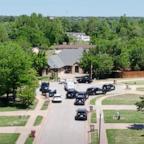Dinosaur "ghost" fossil revealed
MENLO PARK, Calif. -- By the end of today, scientists hope that by using immensely powerful X-rays, they'll get pictures of a ghost. That is, the ghostly remains of a flying dinosaur bird that lived 150 million years ago.
When they're done, using new X-ray technology produced by electrons moving at or near the speed of light, they may have the clearest image ever recorded of what the creature's appearance and body composition. The 16-inch-long Archaeopteryx (pronounced aR-kee-OP-ter-iks) — or "ancient wing" in Greek — lived in the late Jurassic period.
An Archaeopteryx wasn't something you'd want coming towards you fast. Scientist started working late last week on a stone fossil originally discovered in Germany and now owned by the Wyoming Dinosaur Center. Within days, they had scans showing a creature with nasty sharp little teeth on its beak and two really pointy talons at the end of each wing.
"It's kind of like a bird stuffed up a dinosaur's butt," says University of Manchester paleontologist Phil Manning, one of the researchers.
When this particular creature died, it sank to the bottom of a shallow lagoon full of very salty water, where it was entombed in the limestone that preserved it as an amazing fossil. The Archaeopteryx is important because it's a crossover species, an example of evolution in motion, as one branch of dinosaurs was morphing into what would become the ancestors of birds. But only 10 Archaeopteryx fossils have been found, and of those only five are intact enough to tell us much.
The original idea of using new X-ray technology on fossils came from engineer and chemist Robert Morton of the Children of the Middle Waters Institute. His day job is doing chemistry for oil companies, which means he thinks about how to get information about things that might be hidden in very old rocks, such as oil. He heard a talk in the late 1980s and realized that the technique described could also be used to "see" the chemical ghosts of fossils.
Scientists at the Stanford Synchrotron Radiation Lightsource (SSRL) at the SLAC National Accelerator Laboratory, operated by Stanford University for the U.S. Department of Energy, are using this new method to tease out secrets that were embedded in the stone all those millions of years ago. The secrets may tell us more than we ever knew about how the Archeaopteryx lived and flew — and maybe even give us a few hints on how to store spent nuclear fuel as well.




